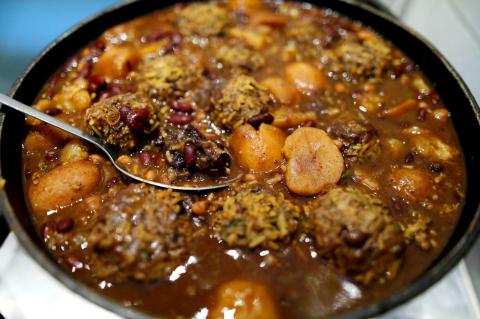Moshe Genzler lifts the lid off a huge aluminium pot, thrusts in a massive spoon and dishes out a steaming portion of beans, potatoes and beef.
It is a Thursday evening at Maadaniat Chef, a small restaurant in the central Israeli ultra-Orthodox city of Bnei Brak specializing in traditional eastern European Jewish food. The gefilte fish and potato kugel pale next to the warm brown glow of the eatery’s crowning glory — hamin — also known as cholent. Consumed by Jews for Saturday lunch since antiquity, the rich stew is enjoying a renaissance in Israel.
While ultra-Orthodox local residents sit at the few tables enjoying their steaming fare, three elderly women and a man, all secular, enter to enquire about the food.

Photo: AFP
The four are from the nearby cities of Givatayim and Ramat Gan and hope to celebrate a birthday with food from their childhood.
“We wanted to try something different,” says one of the women.
A bus drops off a group of senior citizens from Kfar Daniel, a village between Jerusalem and Tel Aviv, with their guide Yair Landsberg.

Photo: AFP
“A dish you ate in your childhood is memories,” he says. “It’s enough that you smell it and you’re full of memories, of nostalgia.”
Genzler — the young son-in-law of the restaurant’s owners — says eating hamin before the Sabbath has become trendy.
“You have people from all walks of life — ultra-Orthodox, secular, all kinds of religious people,” he says. “Groups arrive here as part of a tour of Bnei Brak and enter to see and feel an authentic Jewish experience.”
Hamin, meaning “hot things” in Hebrew, can be traced back to the Mishna, the early oral interpretation of the Torah, as part of the discussion on how food might be kept warm on the Sabbath. Jewish religious law prohibits cooking on Saturday, “but you can prepare something that will begin cooking before the Sabbath and continue to cook or retain its heat during the Sabbath,” notes Shmil Holand, a chef and expert on Jewish culture and food.
“That’s what created this dish.”
The Jews expelled from the land of Israel some 2,000 years ago were split into two parallel routes, one via Babylon to North Africa, Spain, the Balkans and what became the Muslim world.
The other group went to Rome, France and eventually central and eastern Europe. Holand says that over time, each Jewish diaspora created its own variation of the dish, based on the climate and available ingredients.
“Together something new came into being,” he says from the spacious kitchen of his Jerusalem home.
European Jews, who were eventually called Ashkenazim, referred to their hamin as cholent, derived from the French words for hot (chaud) and slow (lent).
And while other people around the world make variations of the dish, hamin stands out for the unusual length of its preparation — normally at least 12 hours, Holand says.
The dish has become a popular winter delicacy in Israel, enjoyed even by people who do not necessarily observe religious law.
‘TASTE OF CHILDHOOD’
A short drive from the Bnei Brak restaurant is Ramat Hahayal, an upscale Tel Aviv neighbourhood favoured by the country’s burgeoning technology sector.
Shuk Hatzafon, a local food court, held a “hamin festival” last month, with variations of the dish from Jewish communities in Austria, Iraq, Italy, India and elsewhere.
The hot spices of the Libyan hamin were balanced out with chard, sold next to a Moroccan version of the dish with groats, chickpeas, potatoes and meat.
Shimon, a young man from Tel Aviv, said hamin “gives you a feeling of home, regardless of your origin.”
Back in Bnei Brak, the religious significance of the dish is still its most important aspect for Genzler.
“Hamin is something that represents the Sabbath for a Jew,” he says.
“It’s been like this for thousands of years and will always remain Jewish food,” he insists.
Bruce Lax, a technician from Ramat Gan who grew up in an ultra-Orthodox neighbourhood in Jerusalem, says Maadaniat Chef’s hamin was the “taste of childhood.”
“It reminds you of places, people, flavours,” says Lax, who like most hamin fans, makes his own too.
His secret ingredient?
“A good bottle of vodka next to it.”

One of the most important gripes that Taiwanese have about the Democratic Progressive Party (DPP) is that it has failed to deliver concretely on higher wages, housing prices and other bread-and-butter issues. The parallel complaint is that the DPP cares only about glamor issues, such as removing markers of Chinese Nationalist Party (KMT) colonialism by renaming them, or what the KMT codes as “de-Sinification.” Once again, as a critical election looms, the DPP is presenting evidence for that charge. The KMT was quick to jump on the recent proposal of the Ministry of the Interior (MOI) to rename roads that symbolize

On the evening of June 1, Control Yuan Secretary-General Lee Chun-yi (李俊俋) apologized and resigned in disgrace. His crime was instructing his driver to use a Control Yuan vehicle to transport his dog to a pet grooming salon. The Control Yuan is the government branch that investigates, audits and impeaches government officials for, among other things, misuse of government funds, so his misuse of a government vehicle was highly inappropriate. If this story were told to anyone living in the golden era of swaggering gangsters, flashy nouveau riche businessmen, and corrupt “black gold” politics of the 1980s and 1990s, they would have laughed.

It was just before 6am on a sunny November morning and I could hardly contain my excitement as I arrived at the wharf where I would catch the boat to one of Penghu’s most difficult-to-access islands, a trip that had been on my list for nearly a decade. Little did I know, my dream would soon be crushed. Unsure about which boat was heading to Huayu (花嶼), I found someone who appeared to be a local and asked if this was the right place to wait. “Oh, the boat to Huayu’s been canceled today,” she told me. I couldn’t believe my ears. Surely,

When Lisa, 20, laces into her ultra-high heels for her shift at a strip club in Ukraine’s Kharkiv, she knows that aside from dancing, she will have to comfort traumatized soldiers. Since Russia’s 2022 invasion, exhausted troops are the main clientele of the Flash Dancers club in the center of the northeastern city, just 20 kilometers from Russian forces. For some customers, it provides an “escape” from the war, said Valerya Zavatska — a 25-year-old law graduate who runs the club with her mother, an ex-dancer. But many are not there just for the show. They “want to talk about what hurts,” she